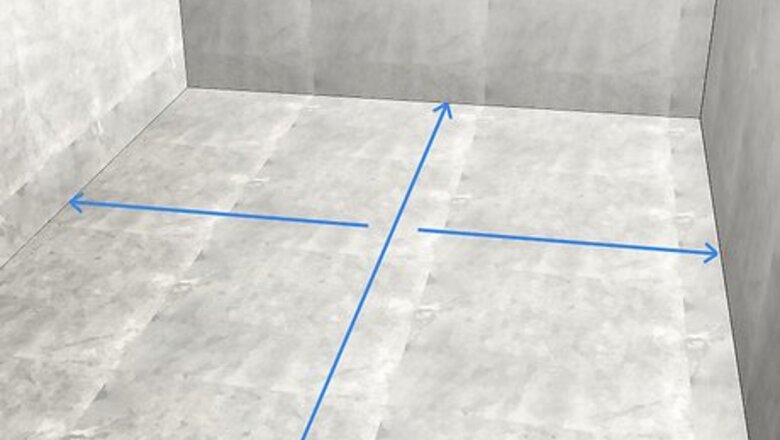
views
Figuring out the Type of Dehumidifier You Need
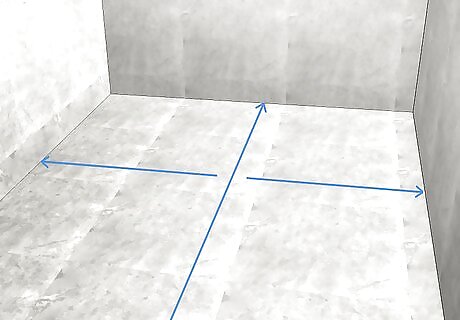
Measure the dimensions of your room or home. When choosing a dehumidifier, you'll need to take into account the size of the space you're trying to dehumidify. If you don't already know how big the space is, use a measuring tape to measure the length and width of the floor. Multiply those measurements together to find the size of the space in square feet or meters. For example, if you're working with a room that is 12 feet (3.7 m) by 10 feet (3.0 m), then the area is 120 square feet (11 m).Did You Know? In most buildings, the ideal relative humidity level (RHL) to keep the space comfortable and prevent bacteria and mold growth is around 30-50%. Most dehumidifiers have a built in humidistat that allows you to set the unit to the optimum humidity level.
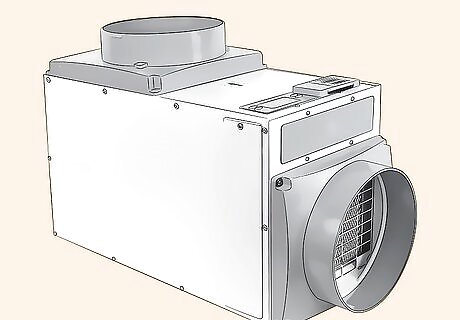
Get a whole-house dehumidifier for a space larger than 2,500 square feet (230 m). If you need to dehumidify an entire house, it might be worthwhile to invest in a whole-house dehumidifier. You can get a unit designed to attach to a pre-existing central heating or air system, or opt for one that can be installed by itself. Whole-house dehumidifiers are designed to work in spaces as large as 3,000 square feet (280 m). While these units are expensive to buy initially, they can save you money and energy in the long run by helping your air conditioner work more efficiently.
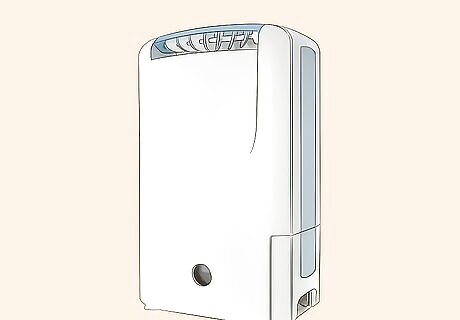
Pick a desiccant dehumidifier for a cooler environment. Dehumidifiers come in 2 basic types: desiccant and refrigerant. While desiccant humidifiers tend to have lower capacity ratings than refrigerant models, they operate much more efficiently in lower temperatures. In general, it's best to use a desiccant dehumidifier if the temperature in your space will fall below 65 °F (18 °C). Desiccant dehumidifiers use a hydrophilic material like silica gel to draw moisture out of the air. Many residential units contain single-use cartridges. They're usually more expensive to run, but they're preferable in cooler spaces. Desiccant dehumidifiers also have the advantage of being quieter than refrigerant models.
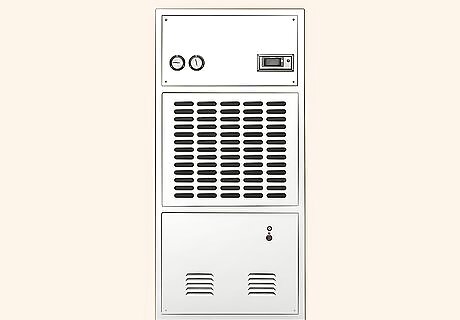
Buy a refrigerant model for a hot and humid space. If your space is consistently hot and humid, a refrigerant dehumidifier may be your best bet. These dehumidifiers tend to have higher capacity ratings and operate more efficiently at high temperatures than desiccant models. A refrigerant dehumidifier uses a heat exchange coil to extract moisture from the air. You can choose a portable refrigerant dehumidifier for smaller spaces, or for a whole-home option, you can choose one that will connect to your central air system. If the temperature drops below 65 °F (18 °C) in the space where you are running your refrigerant dehumidifier, ice may form on the evaporator coils and prevent the unit from functioning properly. You can also use a dehumidifying ventilator if you want to move the humid air outside. These are most suitable for crawl spaces, basements, and attics.
Choosing Your Dehumidifier's Capacity
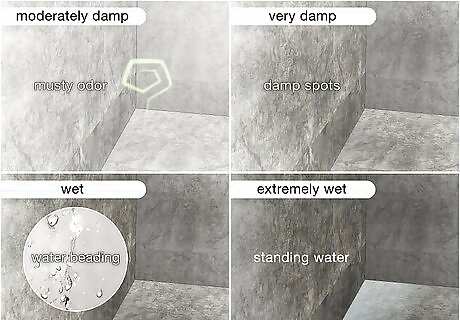
Look for signs of dampness to figure out how wet your space is. While you can measure the exact humidity level of a space using a humidity meter, it's usually not necessary to do precise measurements when choosing a dehumidifier. To get a general sense of how damp your space is, look for clear indicators of humidity, such as condensation inside the windows or damp spots on the walls. For example: Your space is moderately damp if the air feels clammy or damp or you notice a musty odor when the weather is humid. A very damp space always smells musty and feels damp. You may also notice damp spots on the floor or walls. If the space is wet, you may notice water beading on the walls or floors, or moisture seeping in around the edges of the room. The room will feel and smell damp all the time. An extremely wet space will have obvious standing water on the floor.

Get a dehumidifier with a capacity of 10–26 US pints (4.7–12.3 L) for a moderately damp space. The “size” of a dehumidifier actually refers to its capacity—that is, how much water it can pull out of the air in a 24-hour period. If your space is only somewhat damp, you won't need a super high-capacity dehumidifier. The total capacity you need will depend on how big your space is. For example: For a space that's 500 square feet (46 m), a dehumidifier with a 10 US pt (4.7 L) capacity should work. If your space is 1,000 square feet (93 m), get a 14 US pt (6.6 L) dehumidifier. For a 1,500 sq ft (140 m) space, get a 18 US pt (8.5 L) dehumidifier. For a 2,000 sq ft (190 m) space, get a 22 US pt (10 L) dehumidifier. For a 2,500 sq ft (230 m) space, get a 26 US pt (12 L) dehumidifier.
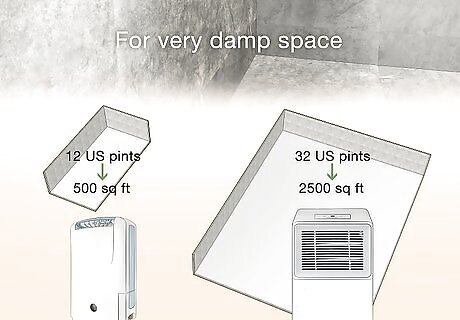
Choose a 12–32 US pt (5.7–15.1 L) dehumidifier for a very damp space. If your space is very damp (e.g., always musty and with damp spots on the floor and walls), opt for a slightly higher-capacity dehumidifier. You'll need to take the size of the space into account as well as the level of dampness. For example, choose a dehumidifier that's: 12 US pints (5.7 L) for a space that is 500 square feet (46 m). 17 US pints (8.0 L) for a space that is 1,000 square feet (93 m). 22 US pints (10 L) for a space that is 1,500 square feet (140 m). 27 US pints (13 L) for a space that is 2,000 square feet (190 m). 32 US pints (15 L) for a space that is 2,500 square feet (230 m).
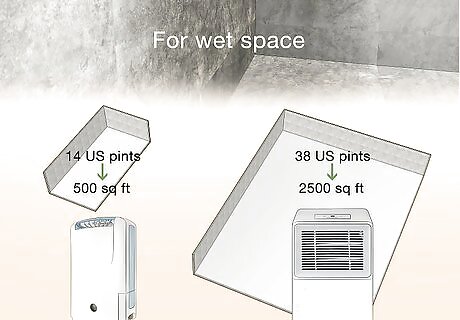
Buy a 14–38 US pt (6.6–18.0 L) dehumidifier for a wet space. For wet spaces (e.g., where there is seepage or sweating on the walls and floors), you'll need a more powerful unit. Select your dehumidifier capacity based on the size of your space. For example, get a dehumidifier that is: 14 US pints (6.6 L) for a space that is 500 square feet (46 m). 20 US pints (9.5 L) for a space that is 1,000 square feet (93 m). 26 US pints (12 L) for a space that is 1,500 square feet (140 m). 32 US pints (15 L) for a space that is 2,000 square feet (190 m). 38 US pints (18 L) for a space that is 2,500 square feet (230 m).
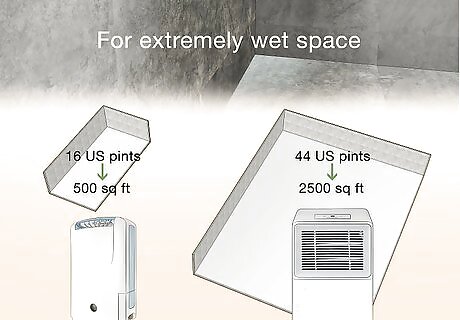
Go for a 16–44 US pt (7.6–20.8 L) dehumidifier for a very wet space. If your space is wet enough to have standing water, purchase a high-capacity dehumidifier based on the size of your space. For example, get a dehumidifier that is: 16 US pints (7.6 L) for a space that is 500 square feet (46 m). 23 US pints (11 L) for a space that is 1,000 square feet (93 m). 30 US pints (14 L) for a space that is 1,500 square feet (140 m). 37 US pints (18 L) for a space that is 2,000 square feet (190 m). 44 US pints (21 L) for a space that is 2,500 square feet (230 m).
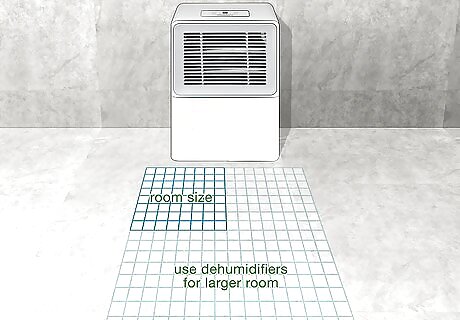
Purchase a dehumidifier with a higher rating than you need to save energy. While larger dehumidifiers are more expensive to buy initially, you may ultimately save money and energy by choosing a machine that's a little higher-capacity than necessary. A higher-capacity dehumidifier won't have to work as hard to keep a space dry as one that's exactly the recommended capacity for the room. For example, even if you're only dehumidifying a small room—e.g., a 144 sq ft (13.4 m) bedroom—it might be worthwhile to invest in a dehumidifier that's rated for 500 square feet (46 m) in a similarly damp environment. You can get large portable dehumidifiers with a capacity of up to 70 US pints (33 L) per day.Tip: In addition to saving energy and wear and tear, getting a larger dehumidifier than you need can help you reduce noise by allowing you to run the machine at a lower setting.














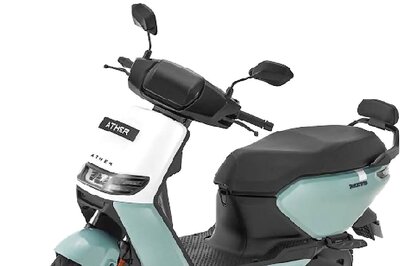





Comments
0 comment